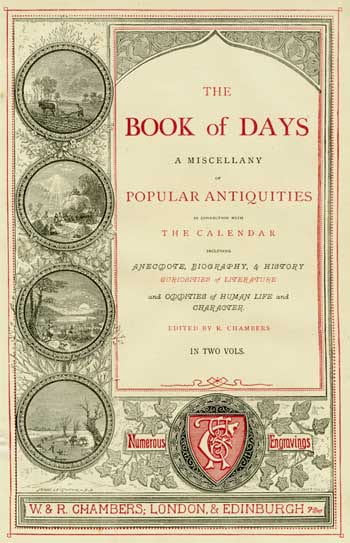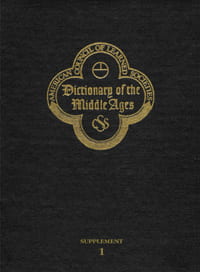The desire to recapture and remember lost episodes from history is not limited to our current time, but has been present in times past. Below are some fascinating reference works containing information about days gone by. It is important that we have these works and that they be preserved to help us remember who we are and where we came from. All of the books listed below are located adjacent to the Reference Desk on the first floor of Gleeson/Geschke.
The Book Of Days: A Miscellany Of Popular Antiquities In Connection With The
Calendar. Robert Chambers, editor.
 This two-volume set from 1869 provides a fascinating look at historical dates and festivals compiled according to the dates of the calendar. A random example is this entry for January 29:
This two-volume set from 1869 provides a fascinating look at historical dates and festivals compiled according to the dates of the calendar. A random example is this entry for January 29:
“George III: The death of George III. on this day in the year 1820, was an event of no political consequence, as for ten years he had been secluded under mental eclipse.”
This set is filled with much similar ephemera and lore, much of which has been forgotten today. Indeed, one of the purposes of this book was
“…while not discouraging the progressive spirit of the age, to temper it with affectionate feelings towards what is poetical and elevated, honest and of good report, in the old national life…”
Even in the Industrial Revolution in mid-19th Century England, there was a desire to preserve some memories of a bygone era.
GLEESON REFERENCE – D11.5 .C44
Haydn’s Dictionary Of Dates And Universal Information Relating To All Ages And Nations, by the Late Benjamin Vincent. 24th ed., Containing The History Of The World To The Summer Of 1906
 This is another collection of facts and information, published in London in 1906. This volume is presented strictly in alphabetical order, with pertinent dates listed under each subject entry. An example:
This is another collection of facts and information, published in London in 1906. This volume is presented strictly in alphabetical order, with pertinent dates listed under each subject entry. An example:
“POOR. The poor of England, till the time of Henry VIII., subsisted as the poor of Ireland until 1838, entirely upon private benevolence. By statute 23 Edw. III. 1349, it was enacted that none should give alms to a beggar able to work.”
Again, this compendium shows the kind of information and facts that was considered to be important among learned Englishmen at the turn of the last century.
GLEESON REFERENCE: D9 .H45 1906
Dictionary of the Middle Ages. Joseph R. Strayer, editor in chief
 This 14-volume dictionary provides a comprehensive set of definitions for terms relating to Medieval literature, art, culture and politics, and key figures. For example, one can find the following entry:
This 14-volume dictionary provides a comprehensive set of definitions for terms relating to Medieval literature, art, culture and politics, and key figures. For example, one can find the following entry:
“ARNULF (ca. 850-899), emperor of illegitimate though royal lineage, deposed Charles the Fat and succeeded him as king of the East Franks in 887.”
This dictionary is highly recommened as an essential reference work for any one who needs to find information on the Middle Ages.
